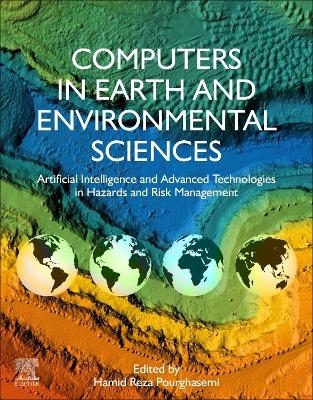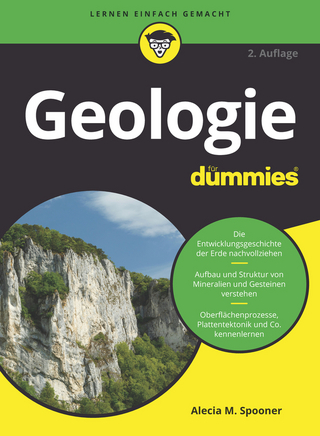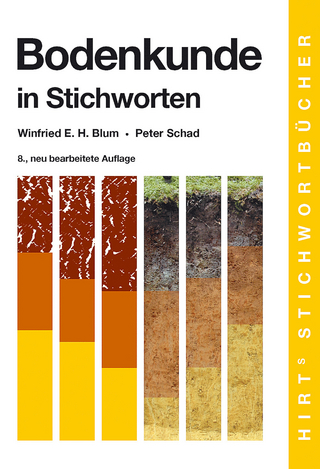
Computers in Earth and Environmental Sciences
Elsevier - Health Sciences Division (Verlag)
978-0-323-89861-4 (ISBN)
Researchers and professionals in Earth and Environmental Science who require the latest technologies and advances in hazards, remote sensing, geosciences, spatial modeling and machine learning will find this book to be an invaluable source of information on the latest tools and technologies available.
Hamid Reza Pourghasemi is a professor of watershed management engineering in the College of Agriculture, Shiraz University, in Iran. His main research interests are GIS-based spatial modelling using machine learning/data mining techniques in different fields such as landslides, floods, gully erosion, forest fires, land subsidence, species distribution modelling, and groundwater/hydrology. Professor Pourghasemi also works on multi-criteria decision-making methods in natural resources and environmental science. He has published over 230 peer-reviewed papers in high-quality journals and seven edited books for Springer and Elsevier and is an active reviewer for over 90 international journals. He was selected as one of the five young scientists under 40 by The World Academy of Science (TWAS 2019) and was a highly cited researcher in 2019 and 2020
1. Predicting Dissolved Oxygen Concentration in River using New Advanced Machines Learning: Long-Short Term Memory (LSTM) Deep Learning.
2. Fractal analysis of valley sections in geological formations of arid areas
3. Data-driven approach for estimating contaminants in natural water
4. Application of analytical hierarchy process (AHP) in landslide susceptibility mapping for Qazvin province, N Iran
5. Assessment of machine learning algorithms in land use classification
6. Evaluation of land use change predictions using CA-Markov model and managerial scenarios
7. Topographical features and soil erosion processes
8. Mapping the NDVI and monitoring of its changes using Google Earth Engine and Sentinel-2 images
9. Spatiotemporal Urban Sprawl and Land Resource Assessment using Google Earth Engine Platform in Lahore District, Pakistan
10. Using OWA - AHP method to predict landslide-prone areas
11. Multi-scale drought hazard assessment in the Philippines
12. Selection of the best pixel-based algorithm for land cover mapping in Zagros forests of Iran using Sentinel-2A satellite image: A case study in Khuzestan province
13. Identify the important driving forces on gully erosion, Chaharmahal and Bakhtiari province, Iran
14. Analysis of social resilience of villagers in the face of drought using LPCIEA indicator, Case study: Downstream of Dorodzan dam, Iran
15. Spatial and seasonal modelling of land surface temperature using Random Forest
16. Municipal solid waste landfill suitability analysis through spatial multi-criteria decision analysis: a case study
17. Predictive habitat suitability models for Teucrium polium L. using boosted regression trees
18. Ecoengineering practices for Soil degradation protection for vulnerable hill slopes
19. Soft computing applications in rainfall induced landslide analysis and protection – Recent trends, techniques, and opportunities
20. Remote sensing and machine learning techniques to monitor fluvial corridor evolution: the Aras River between Iran and Azerbaijan
21. Studies on potential plant selection focusing on soil bioengineering application for land degradation protection
22. IoT applications in landslide prediction and abatement – Trends, opportunities and challenge
23. Application of WEPP model for runoff and sediment yield simulation from ungauged watershed in Shivalik foothills
24. Parameter estimation of a new four-parameter Muskingum flood routing model
25. Predicting areas affected by forest fire based on machine learning algorithm
26. Management of pest-infected oak trees using remote sensing-based classification algorithms and GIS data
27. The COVID-19 Crisis and Its Consequences for Global Warming and Climate Change
28. Earthquake anomalies for global events from GNSS TEC and other satellites
29. Landslide spatial modelling using a bivariate statistical method in Kermanshah Province, Iran
30. Normalized Difference Vegatation Index analysis of Forest Cover Change Detection in Paro Dzongkhag, Bhutan
31. Rate of penetration prediction in drilling wells from the Hassi Messaoud oil field (SE Algeria): use of artificial intelligence techniques and environmental implications
32. Soil erodibility and its influential factors in arid and semi-arid regions of the Middle-East
33. Non-carcinogenic health risk assessment of fluoride in groundwater of the alluvial plains of River Yamuna, Delhi, India
34. Digital soil mapping of organic carbon at two depths in loess hilly region of Northern Iran
35. Hydrochemistry and geogenic pollution assessment of groundwater in Akşehir (Konya/Turkey) using GIS
36. Comparison of the frequency ratio, index of entropy, and artificial neural networks models for landslide susceptibility mapping: A case study in Pınarbaşı/Kastamonu (North of Turkey)
37. Remote Sensing Technology for Post-Disaster Building Damage Assessment
38. Doing More with Less: Coupling Morphometric Indices for Automated Gully Pattern Extraction (A Case Study in the Southeast of Iran)
39. Identification of land subsidence prone areas and its mapping using machine learning algorithms
40. Monitoring of Spatiotemporal Changes of Soil Salinity and Alkalinity in Eastern and Central Parts of Iran
41. Fine-grain Sparse Woodlands Mapping, Using Kernel-based Granulometry of Textural Pattern Measures on Satellite Imageries
42. Badland erosion mapping and effective factors on its occurrence using random forest model
43. Application of machine learning algorithms in Hydrology
44. Digital soil mapping of bulk density in loess derived- soils with complex topography
45. Landslide Susceptibility Mapping along the Thimphu-Phuentsholing Highway using Machine Learning
46. Drought Assessment using the Standardized Precipitation Index (SPI) in Greece
47. COVID-19: An overview on official reports in Iran and world along with some comparisons to other hazards
48. Multi-hazard risk analysis and governance across a provincial capital in northern Iran
| Erscheinungsdatum | 01.10.2021 |
|---|---|
| Zusatzinfo | 300 illustrations (100 in full color); Illustrations |
| Verlagsort | Philadelphia |
| Sprache | englisch |
| Maße | 216 x 276 mm |
| Gewicht | 1810 g |
| Themenwelt | Mathematik / Informatik ► Informatik |
| Naturwissenschaften ► Geowissenschaften ► Geologie | |
| Technik ► Luft- / Raumfahrttechnik | |
| ISBN-10 | 0-323-89861-0 / 0323898610 |
| ISBN-13 | 978-0-323-89861-4 / 9780323898614 |
| Zustand | Neuware |
| Informationen gemäß Produktsicherheitsverordnung (GPSR) | |
| Haben Sie eine Frage zum Produkt? |
aus dem Bereich


